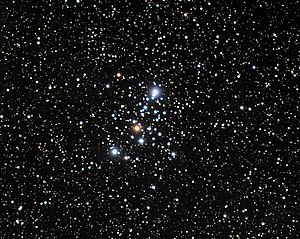Messier 103
| Messier 103 | |
|---|---|
 Open cluster Messier 103 in Cassiopeia | |
| Observation data (J2000.0 epoch) | |
| Right ascension | 01h 33.2m |
| Declination | +60° 42′ |
| Distance | 9,400 light-years (2.884 ± 0.313 kpc[1]) |
| Apparent magnitude (V) | 7.4[2] |
| Apparent dimensions (V) | 6.0' |
| Physical characteristics | |
| Estimated age | 12.6 ± 0.2 million years[1] |
| Other designations | NGC 581, Cr 14 |
| Associations | |
Messier 103 (also known as M103, or NGC 581) is a small open cluster of many faint stars in Cassiopeia. It was discovered on 20 September 1781 by Pierre Méchain, but later added as Charles Messier's last deep-sky object in his catalogue.[3]
It is located 9,400 light-years from the Sun[1][3] and is about 15 light years across. It holds two prominent stars, of which the brightest is magnitude 10.5, and in the center of the cluster, another magnitude 10.8 red giant. Another bright foreground object is the double star Struve 131,[4] but is not a member of the cluster. Cluster membership is about 172 stars based on >50% probability of gravitational attachment that binds the cluster together.[4] M103 is between 12.6[1] to 25 million years[5] in age.
Observation history[edit]
After the discovery of Messier 101 through 103 by Pierre Méchain, Messier later added this open cluster to his own catalogue.[4][6] In 1783, William Herschel described the region of M103 as 14 to 16 pL (pretty large stars) and with great many eS or extremely faint ones.[7] Åke Wallenquist first identified 40 stars in M103 while Antonín Bečvář raised this to 60. Archinal and Hynes suggest that the cluster has 172 stars.[4] Admiral William Henry Smyth pointed out the cluster's 10.8-magnitude red giant, citing it was a double star on Cassiopeia's knee, about 1° northeast of Delta Cassiopeiae, sometimes called as Ruchbah or Rukhbah.
Telescopic View[edit]
Messier 103 is an easy object to find[8] and the cluster is visible in binoculars or a small telescope.[9] object to find and the cluster is visible even with the use of binoculars.[4][10] M103 can be seen as a nebulous fan-shaped patch, and is about a fifth the apparent diameter of the Moon or 6 arcminute (6′) or 0.1° across. To find M103, it is suggested that the observer center on Ruchbah or the lowest star of the signature “W” asterism of Cassiopeia. The cluster will appear as a hazy patch in a field about 1⁄3 the length of an imaginary line towards Epsilon Cassiopeiae, a northern endpoint of the 'W', and placed on the outer side of the 'W'.
Gallery[edit]
-
M103 image from Aladin Sky Atlas
-
Finder chart for M103
See also[edit]
References and footnotes[edit]
- ^ a b c d Sanner, J.; Geffert, M.; Brunzendorf, J.; Schmoll, J. (1999). "Photometric and kinematic studies of open star clusters. I. NGC 581 (M 103)". Astronomy and Astrophysics. 349: 448–456. arXiv:astro-ph/9908059. Bibcode:1999A&A...349..448S.
- ^ "Messier 103". SEDS Messier Catalog. Retrieved 30 April 2022.
- ^ a b Robert Bruce Thompson [1], M103 (open cluster in Cassiopeia). Accessed online 13 April 2011
- ^ a b c d e "Messier 103: Observations and Descriptions". SEDS. Retrieved 13 April 2011.
- ^ Huang, W; Gies, D.R.; McSwain, M.V. (2010). "A stellar rotation census of B stars: from ZAMS to TAMS". Astrophysical Journal. 722: 605–619. arXiv:1008.1761. Bibcode:2010ApJ...722..605H. doi:10.1088/0004-637X/722/1/605. S2CID 118532653.
- ^ "3 Clusters in Cassiopeia". One Minute Astronomer. Archived from the original on 22 February 2011. Retrieved 14 April 2010.
- ^ "Messier 103". Universe Today. 7 January 2010. Retrieved 14 April 2010.
- ^ "Messier 103". Perez Media. Retrieved 14 April 2010.
- ^ "Messier 103". Perez Media. Retrieved 14 April 2010.
- ^ "The Constellation Cassiopeia". Zimbio. Archived from the original on 11 October 2012. Retrieved 14 April 2010.
External links[edit]
- Open Cluster M103 @ SEDS Messier pages
- Open Cluster M103 @ Skyhound.com
- NASA Astronomy Picture of the Day: Distant Open Cluster M103 (7 February 2001)
- Messier 103 on WikiSky: DSS2, SDSS, GALEX, IRAS, Hydrogen α, X-Ray, Astrophoto, Sky Map, Articles and images



